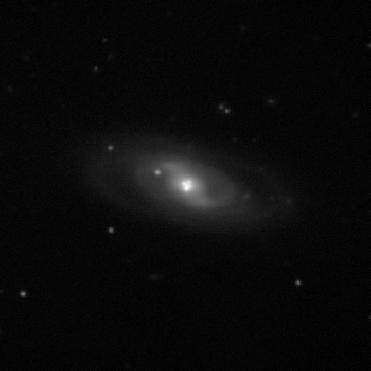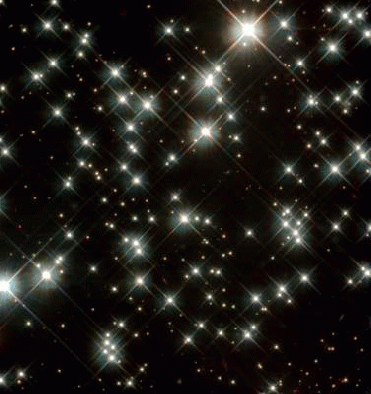
The Einstein Cross and the galaxy that causes this 'cosmic mirage', as seen with the FORS instrument on ESO's Very Large Telescope. ESO image
PARIS (BNS): A team of astronomers from Europe and the US have studied the inner parts of the disc around a super massive black hole 10 billion light years away, providing the first observational confirmation of the prevalent theoretical models of such discs.
Combining a double natural 'magnifying glass' with ESO�s Very Large Telescope (VLT) the astronomers were able to study the disc with a level of detail a thousand times better than that of the best telescopes in the world.
Studying the 'Einstein Cross', a famous cosmic mirage, they said that this cross-shaped configuration consists of four images of a single very distant source.
"The multiple images are a result of gravitational lensing by a foreground galaxy, an effect that was predicted by Albert Einstein as a consequence of his theory of general relativity. The light source in the Einstein Cross is a quasar approximately ten billion light-years away, whereas the foreground lensing galaxy is ten times closer. The light from the quasar is bent in its path and magnified by the gravitational field of the lensing galaxy."
This magnification effect, known as 'macro-lensing', in which a galaxy plays the role of a cosmic magnifying glass or a natural telescope, proves very useful in astronomy as it allows us to observe distant objects that would otherwise be too faint to explore using currently available telescopes.
"The combination of this natural magnification with the use of a big telescope provides us with the sharpest details ever obtained," said Fr�d�ric Courbin, leader of the programme studying the Einstein Cross with ESO's Very Large Telescope.
Astronomers said in addition to macro-lensing by the galaxy, stars in the lensing galaxy act as secondary lenses to produce an additional magnification. "This secondary magnification is based on the same principle as macro-lensing, but on a smaller scale, and since stars are much smaller than galaxies, is known as 'micro-lensing'. As the stars are moving in the lensing galaxy, the micro-lensing magnification also changes with time. From Earth, the brightness of the quasar images (four in the case of the Einstein Cross) flickers around a mean value, due to micro-lensing. The size of the area magnified by the moving stars is a few light-days, i.e., comparable in size to the quasar accretion disc."
"The micro-lensing affects various emission regions of the disc in different ways, with smaller regions being more magnified. Because differently sized regions have different colours (or temperatures), the net effect of the micro-lensing is to produce colour variations in the quasar images, in addition to the brightness variations. By observing these variations in detail for several years, astronomers can measure how matter and energy are distributed about the supermassive black hole that lurks inside the quasar. Astronomers observed the Einstein Cross three times a month over a period of three years using VLT, monitoring all the brightness and colour changes of the four images," the ESO said.
"Thanks to this unique dataset, we could show that the most energetic radiation is emitted in the central light-day away from the supermassive black hole and, more importantly, that the energy decreases with distance to the black hole almost exactly in the way predicted by theory," said Alexander Eigenbrod, who completed the analysis of the data.
The use of the macro- and micro-lensing, coupled with the giant eye of the VLT, enabled astronomers to probe regions on scales as small as a millionth of an arcsecond. This corresponds to the size of a one euro coin seen at a distance of five million km, i.e., about 13 times the distance to the Moon! "This is 1000 times better than can be achieved using normal techniques with any existing telescope," Courbin said.
Measuring the way the temperature is distributed around the central black hole is a unique achievement. Various theories exist for the formation and fuelling of quasars, each of which predicts a different profile. So far, no direct and model-independent observation has allowed scientists to validate or invalidate any of these existing theories, particularly for the central regions of the quasar.
"This is the first accurate and direct measurement of the size of a quasar accretion disc with wavelength (colour), independent of any model," concludes team member Georges Meylan.
 Previous Article
Previous Article Next Article
Next Article













The Indian Air Force, in its flight trials evaluation report submitted before the Defence Ministry l..
view articleAn insight into the Medium Multi-Role Combat Aircraft competition...
view articleSky enthusiasts can now spot the International Space Station (ISS) commanded by Indian-American astr..
view article